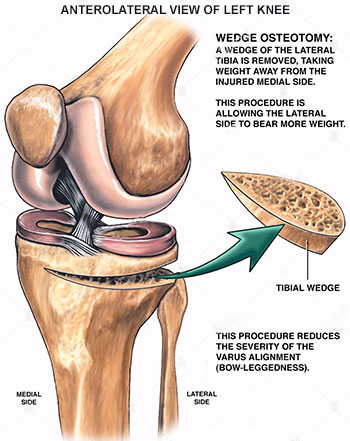
Osteoarthritis can develop when the bones of lower limb do not line up properly. This can put extra stress on the inner (medial) side of knee. Over the time, this extra pressure on medial side can wear away the smooth cartilage that protects the bones, causing pain and stiffness in knee.
High Tibial Osteotomy is an effective surgery for the treatment of knee malalignment with associated pain and stiffness from arthritis in middle-aged active patients. Osteotomy literally means “cutting of the bone”. In a HTO surgical procedure, the tibia (shinbone) is cut near knee joint and then reshaped to relieve pressure from medial (inner) side of the knee joint. By shifting weight off of the damaged medial side of the knee joint to normal side of knee, the surgery can relieve pain and significantly improve function of an arthritic knee.
It can correct poor knee alignment and delay the need of Total Knee Replacement by 10 to 15 years. Another advantage is that there are no restrictions on physical activities after a High Tibial Ostetomy. Patients are be able to comfortably participate in their favorite activities and even indulge high impact exercise.
Appropriate patient selection, proper osteotmy types and precise surgical techniques are essential to success of High tibial osteotomy and here comes the role of experienced surgeon like Dr. Riddhivardhan, who has done large number of High Tibial Ostetomy surgical procedures with excellent results
HTO Procedure

During this procedure, a wedge of bone is removed from the outside of the tibia, under the healthy side of the knee. When the wedge is closed, it straightens the leg. This brings the bones on the healthy side of the knee closer together and creates more space between the bones on the damaged medial, arthritic side. As a result, the knee can carry weight more evenly, easing pressure on the painful medial side to lateral side and use staple or plate to fix the osteotomy.
Candidates for High Tibial Osteotomy
High Tibial Osteotomy is most effective for active patients who are 40 to 60 years old. Good candidates have pain on only one side of the knee, and no pain under the kneecap. Knee pain should be brought on mostly by activity, as well as standing for a long period of time.
Candidates should be able to fully straighten the knee and bend it at least 90 degrees. Patients with rheumatoid arthritis are not good candidates for osteotomy.
Before & After Surgery
Usually four days of hospital admission is required for HTO surgery. Patient will be admitted one day prior to surgery for detailed workup and anesthetic check up. Twenty four hours after surgery the patient will be assisted to walk with the aid of a walker with non weight bearing assistance and made independent for toilet activities. On the fourth day the patient will be discharged from the hospital.
Patient will need physiotherapy after 6 week for regaining movement and strengthening muscle of knee joint. After 3 weeks of surgery, the patient will need to come to the hospital for stitches removal and change of cast. After that the patient will be called after 2 months for follow up and reassessment of his/her knee movement.
